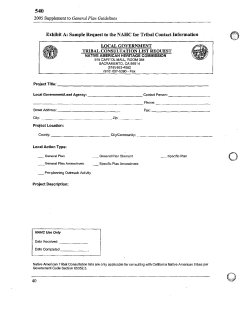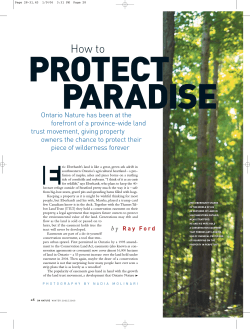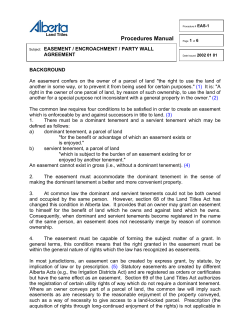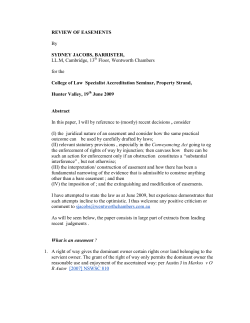
Document 344993
IN THE COURT OF APPEALS
STATE OF NEW MEXICO
ROBERT CIOLLI
and MARY LOU CIOLLI
Appellees/Appellee
vs.
Docket No.32,241
McFARLAND LAND & CATTLE CO. INC.
Appellant/Appellant
APPELLANT’S BRIEF IN CHIEF
Appeal taken from County of Quay, Tenth Judicial District Court. Honorable
Albert J. Mitchell, Jr., District Judge.
Filed by:
SCHUTTE LAW OFFICE, LLC
Donald Schutte, Attorney for Appellant/Appellant
P0 Box 1091
Tucunicari, New Mexico 88401
575-461-6111
Fax 575-461-6010
TABLE OF CONTENTS
(1) STATEMENT OF THE NATURE OF THE CASE
I
(2) COURSE OF PROCEEDINGS
I
(3) SUMMARY OF FACTS RELEVANT TO THE APPEAL
I
POINT TWO AS RAISED BY THE COURT:
Effect of quiet title on an easement by necessity
3
POINT ONE: Did the Trial Court error in granting
Appellees an easement based upon a conclusion that
an unwritten easement existed.
6
4. ARGUMENT
7
Point One: Did the Trial Court error in granting
Appeilees an easement based upon a conclusion that
an unwritten easement existed.
Standard of Review
7
Discussion
7
Express Agreement
8
Easement by Prescription
9
Point Two, Does a Quiet Title Judgment extinguish
an easement by implication or necessity.
10
Standard of Review
10
Discussion
10
(5)
Right for Any Reason
10
Quiet Title Actions
ii
Easement by Necessity/Implication
13
CONCLUSION
14
—Ii
TABLE OF AUTHORITIES
New Mexico Cases:
Algermissen v. Sutin, 2003-NMSC-001 ¶10.
9.10
Beaver v. Brumlow, 2010NMCA-033, ¶16
8
City of Rio Rancho v. AMREP Southwest, Inc. 201 1-NMSC-037
¶ 33
Currier v. Gonzales, 78 N.M. 541, 434 P.2d 66(1967)
7,8
12
Herrera v. Roman Catholic Church, 112 N.M. 717, 720,
819 P.2d 264, 267 (Ct. App.l99l).
Hovetv. Allstate Ins, Co., 2004-NMSC-010,
8
¶
10.
10,12
Hurlocker v. Medina, 118 N.M. 30, 31, (Ct. App. 1994)
13
Kennedy v. Bond, 80 N.M. 734, 736, 460 P.2d 809, 811(1969).
7
Meiboorn v. Watson, 2000-NMSC-0044, {20}
11
Ouintana v. Vigil. 46 N.M. 200, 125 P.2d 711(1942)
12
Pacheco v. Martinez, 97 N.M. 37, 4142, (Ct. App. 1981).
12
Ritter- Walker Co. v. Bell, 46 N.M. 125, 126, 123 P.2d 381, 382 (1942)
8
State v. Grani/lo-Macias, 2008-NMCA-02 1, ¶ 7
7
Other State Jurisdictions
‘“vlie v. Lewis. 83 So.2d 346, 347 (1955).(Alabarna)
—111—
13
Federal Jurisdictions
Corman v. Cree, 100 F.2d 486 (1938).
12
New Mexico Statutes
§426-1 et, seq. NMSA, 1978
11
§4262 NMSA, 1978.
12
RECORDED TRANSCRIPT
The recorded transcript was taken by For The Record equipment and
sofiwear. References to the recorded transcript are by clock time.
STATEMENT OF COMPLIANCE
This brief was prepared using a proportionally space type style or type face,
Times New Roman, and the body of the brief contains 3,267 words as indicated
by WordPerfect. version X5.
-i v
(1)
STATEMENT OF THE NATURE OF THE CASE
This was a matter brought below for Declaration of an Easement in favor of
Appellees upon the lands of Appellant.
(2)
COURSE OF PROCEEDINGS
Appeflee filed his complaint for Declaration of an Easement against
Appellant on August 26, 2011 seeking an easement by prescription or alternatively
upon an implied easement (RP 1). Appellant filed its Answer on October 12, 2011
generally denying the allegations of the Complaint and raised defenses, inter al/a,
of permissive use and res judicata based upon a prior Quiet Title action against
Appellees’ predecessors in title (RP 26). The matter proceeded to trial on January
30, 2012. (RP 44-65). The parties filed their respective requested Findings of Fact
and Conclusions of Law (RP 73 and 94). The Court entered its Findings of Fact
and Conclusions of Law on March 12, 2012 (RP 101) and entered its Judgment
granting the easement on May 10, 2012 (RP 1 14). Appellant filed its Notice of
Appeal on May 31, 2012 (RP 122)
(3) SUMMARY OF FACTS RELEVANT TO THE APPEAL
Appellees and Appellant own adjoining parcels of ranch land in Quay
County, State of New Mexico. Appellees’ property is described as follows:
TOWNSHIP EIGHT (8) NORTH, RANGE THIRTY-TWO (32) EAST.
N.M.P.M.
Section 3: SW/4NW/4 (Lot 9). W/2sw/4, and Lots 6, 7, 10, and 11
Section 4: SE/4 and SE/4NE/4 (Lot 9)
(hereinafter ‘Ciolli Ranch”)
The property owned by Appellant at issue in this litigation is described as follows:
TOWNSHIP EIGHT (8) NORHT, RANGE THIRTY-TWO (32) EAST,
N.M.RM. Section 9: E/2
(RP 1 and RP 26)
This particular parcel is part of a much larger ranch owned by Appellant which
consists of several thousand acres but for purposes of this appeal the parcel in
question will be referred to as “McFarland Ranch”. Appellant purchased the
property identified as McFarland Ranch in 1970 from Benton Hodges (“Hodges”).
The deed from Hodges to McFarland did not reserve any easement or other right
of access across the property deeded to McFarland.(Exhibit 01-30-12-A) Hodges
also owned the property known as “Ciolli Ranch” at the time of sale to McFarland
Ranch (Tr. 1:42:39PM). At the time of sale from Hodges to McFarland, Hodges
accessed the property designated as Ciolli Ranch from the North and East from
NM State Highway 284 (Latham Route) and not across the property conveyed to
McFarland (Yr. 1:44:30PM, Tr. 1:45.45, Tr. 1:48:50. Yr. 1:50:45, Exhibit 01-3012-B). Although it was commonly accepted and permitted practice among the
adjoining ranch owners in this area to come on to or cross adjoining ranches as
necessary for ranching purposes (Tr. 1 1:22:45, Tr. 1:53:20PM). McFarland
Ranches had a “feed road” running north and south along its eastern boundary
from which livestock could be fed, moved or transported. This feed road continued
onto the Ciolli Ranch as McFarland would lease the grass for cattle grazing on the
Ciolli Ranch from Hodges prior to the purchase by Ciolli and used this route to
care and feed cattle (Yr. 1:50:02PM).
Hodges died in 1975 and no evidence was presented as to adverse use of or
access across McFarland Ranch to the Ciolli Ranch from 1975 to 1997. In 1980,
Appellant McFarland Ranch bought a Quiet Title action regarding the parcel of
land Appellant had purchased from Hodges in Quay County in CV8O-00028 in the
Tenth Judicial District Court and by Final Decree dated May 15, 1980, title to
McFarland Ranch was quieted against all named and all unknown claimants,
including Hodges heirs (Ex, 01-30-12 B, Court’s Findings No, 2, RP 101).
[POINT TWO AS RAISED BY THE COURTI
In 1997, Appellees entered into a real estate contract to purchase what is
now ‘Ciolli Ranch” from an heir of Hodges (Tr. 10:36:40AM). Appellees resided
in the State of Washington at the time of purchase and moved to Quay County in
2002 (Yr. 10:36:37AM). Appellees visited Ciolli Ranch by means of a hand drawn
map which directed access across the feed road on McFarland Ranch (Tr.
10:16:50, Ex. 0130-122). Appellees visited the Ciolli Ranch once a year in 1997,
1998, 1999 and 2000. They did not visit the Ciolli Ranch in 2001(r.
10:38:02AM). McFarland Ranch was unaware of the Appellees’ use of the feed
road at the time (Yr. 2:17:00 PM, Yr. 11:01:05AM).
In 2002 or 2003, Appellees desired to sell the Ciolli Ranch and learned that
they did not have a recorded easement to gain access to their property across any
of the adjoining ranches including McFarland Ranch (Yr. 10:39:10 AM,
10:41:50AM). Appellees, as well as their real estate broker, visited the Appellant
to request a written easement across McFarland Ranch (Yr. 11:01:10).
Appellant declined to give a written easement but gave Appellees
permissive use of the feed road to access the Ciolli Ranch ( Tr. 11:21 :01
23:O6AM, Tr, 1:35:18 PM, Tr, 1:55:34 PM, Tr, 2:13:10 PM). Atthe time there
were alternative routes of access from public roadways to Ciolli Ranch (10:57:10),
including the Latham route, which was the shortest and most direct although none
of these access routes was recorded (Yr. 1:56:13PM).
At some time in 2011 Appellees attempted to sell the property at issue and
again requested a written grant of easement from Appellant which Appellee
declined to do although verbal permission was again given to Appellee to use the
feed road access. (Tr. 2:13:05 PM). This litigation followed,
On October August 26, 201 1, Appellees filed their Complaint seeking a
declaration of a prescriptive easement by adverse possession or a private implied
easement (RP 1). Appellees alleged that an actual dispute existed justifying
declaratory relief in that Appellants disputed the existence of an easement.
Appellant admitted that a dispute existed over the existence of an easement as
claimed by Appellees, and further, Appellants filed its Answer denying that any
easement existed and stated that title to McFarland Ranch had been quieted by
Judgment and that the Appellees’ usage of the feed road on McFarland Ranch had
been permissive at all times (RP 26). After trial on the merits on January 30, 2012,
Appellant submitted requested findings of fact.(RP 94). These requests included
findings that no evidence was presented as to adverse use of or access across
McFarland Ranch to the Ciolli Ranch from 1975 to 1997. (Request No.8) Further
that there was no evidence that there
was
any adverse nonpermissive use of
Appellant McFarland’s feed road by any person from 1997 to 2002. (Request No,
16). And further that in 2002 Or 2003 Appellant gave Appellee permission to use
the feed road to access the Ciolli Ranch, (Request No. 18), Appellant also
requested a finding that Appellant has never admitted nor agreed that Appellees
had a “right of access” across its property. (Request No. 23). The Court did not
make specific findings in accord with these requests. CHALLENGED POiNT
ONE
The Court entered its Findings of Fact and Conclusions of Law on March
12. 2012. (RP 101). In it Findings the Court found:
1. There is clear and convincing evidence that the Appellees right to
cross the Appellant’s property has never been in dispute.
CHALLENGED POINT ONE.
2. Appellant filed a quiet title suit in Cause No. D-10lO-CV-198000028. This quieted title to the Appellant’s land as against the Appellees
predecessors in title.
3. Throughout the quiet title action, and continuing through the present, at
no time did McFarland Land and Cattle Co. deny the Appellees nor the
Appellees predecessor’s access to their property. The statements of Mr.
McFarland, (also known as Shine McFarland) are valid statements, binding
upon the corporation, as they were made in his role as president of the
corporation. The corporation was present during trial, and testified through
its current president, Kelly McFarland, CHALLENGED POINT ONE
4. At all times, the position of McFarland Land and Cattle has been that the
Appellees, and their predecessors in title, have the right to cross Appellant’s
land to access Appellees property. CHALLENGED POINT ONE
Based upon these Findings the Court concluded as a matter of law:
1. This is not a lawsuit regarding whether or not an easement exists. No
testimony was given that indicates Appellees could not cross the land of
McFarland Land and Cattle, or that McFarland Land and Cattle would stop
the Appellant from crossing their land, The dispute in this matter focused
only upon whether or not the easement could be reduced to writing, and
how the terms of the easement would be defined.
CHALLENGED POINT ONE
4. ARGUMENT
-6-
Point One, Did the Trial Court error in granting Appellees an
easement based upon a conclusion that an unwritten easement existed.
Standard of Review
The standard of review to be applied to a lower court’s legal conclusions is
de novo State v. Granillo-Macias, 2008.-NMCA-021. ¶ 7, 143 N.M. 455, 176 P.3d
1187
Discussion
While it is clear that the district court ordered that an easement in favor of
Appellee existed and that a written easement should be entered in favor of
Appellee, it is less then clear as to how the court arrived at that conclusion of law
since elements of either an express easement or of an easement by prescription
were not supported by the factual findings
reference
to
existence
of
“right
an
crossS
to
of
the district
court.
The district court’s
must be interpreted as discussed below as the
easement.
“An easement
is
distinguished from a
fee,
and constitutes a liberty,
privilege, right, or advantage which one has in the land of another.” Kennedy
v.
Bond, 80 N.M. 734, 736, 460 P.2d 809, 811(1969). “An easement creates a
nonpossessory right to enter and use land in the possession of another.
Rio Rancho v.AMREP Southwest, Inc. 201 l-NMSC-037 ¶ 33, and’.
-7-
.
.
.“
may
Cit of
be
created by express agreement, prescription or by implication”, Herrera v. Roman
Catholic Church. 112 N.M. 717, 720, 819 P.2d 264, 267 (Ct. pp.991).
re.s Agrcetn
Appellant agrees with the district court that an easement must be in writing
as it found in its Conclusions (RP 102). This conclusion is in accord with other
case law See Cit qf Rio Rancho v. AMREF S4’ Inc. 2011-NMSC-037
¶ 37, (An
easement described in a recorded instrument must be in writing.
See also,
.
.
.“),
Ritter- Walker Co. v. Bell, 46 N.M. 125, 126, 123 P.2d 381, 382 (1942),’[tjit1e to
an easement passes like title to any other real estate and the statute of frauds
requires that a grant of an easement be in writing unless acquired by adverse user.
See also, Beaver v. Brumlow, 2010-NMCA-033, ¶16, in general discussing the
English Statute of Fraud wherein “No action shall be brought upon any contract or
sale of lands,.. or any interest in or concerning them.
.
. .
unless the agreement
upon which such action shall be brought, or some memorandum or note thereof,
shall be in writing, signed by the party to be charged therewith, or by some person
thereunto by him lawfully authorized.”
in the present appeal, the district court did not find that there was any grant
of easement by Appellant in writing nor did Appellee ever make such a
contention. Specifically, the conclusion of the district court recognizes the absence
-8-
of any written grant of easement (RP 101, Conch No 1). Accordingly, the apparent
recognition by the court of an unwritten express easement which should now be
recognized is in error as a matter of law.
entbPrescrition
For an easement by prescription to be created the Appellee needed to show
“an adverse use of land, that is open or notorious, and continued without effective
interruption for the prescriptive period” Algermissen v. Sutin, 2003-NMSC-00 1
¶10. In the present case the district court did not make any finding that the use of
the feed road was “adverse”, but rather the district court specifically found that no
time did Appellants deny the Appellees access to their property (Rp 101). The
permissive use of the feed road was acknowledged by Appellee (Tr. 1 1:23:06).
We must determine whether there was sufficient
evidence to support the finding that Defendants gave
permission to Plaintiffs to cross their land. As stated
earlier, the fact finder should presume adversity if all of
the other elements of the claim are satisfied, and there is
no evidence of express permission
It is important to
recognize what this does not mean. This does not mean
that a landowner must demonstrate that he or she gave
express permission in order to defeat a prescriptive
easement claim. Our cases demonstrate that implied
permission is also permission sufficient to rebut the
presumption. In Hester, we said that “if a use has its
inception in permission, express or implied, it is stamped
with such permissive character and will continue as such
until a distinct and positive assertion of a right hostile to
the owner is brought home to him by words or
acts.(citations omitted)
Algermissen v Sutin, 2003-NMSC001 { 12}
The district court’s findings of permissive use by Appellee is supported by
the testimony as outlined above and would defeat any claim of right based upon
prescription.
Point Two. Does a Quiet Title Judgment extinguish an easement by
implication or necessity.
Standard of Review
“Statutory interpretation is a question of law, which we review de novo.”
1-Jovet v. Allstate Ins, Co., 2004-NMSC0 10,
¶
10.
Discussion
In the district court’s findings the court found that the Quiet title action
“quieted title to the Appel1ants land as against the Appellees predecessors in
title,” (RP 101, Finding No, 2). The district court, consequently, did not find nor
conclude that an easement by implication or necessity existed, Appellees did not
appeal from this finding or conclusion, Rather, the Court of Appeals has requested
that the parties address this issue due to its potential applicability to a “right for
any reason” analysis by the Court,
fonv Reason
-1 0
In the first Notice of Proposed Summary Disposition, filed August 21, 2012,
this Court proposed summary affirmance, not on the findings or conclusions of the
district court, but rather upon the doctrine of “right for any reason.” This doctrine
would allow the appellate court to “affirm a district court ruling on a ground not
relied upon by the district court, [but] will not do so if reliance on the new ground
would be unfair to appellant..... This Court, however, on appeal.
assume the role of the trial court and delve into.
.
.
.
.
will not
fact-dependant inquiries.”
Meiboorn v. Watson, 2000-NMSC-0044, {20}. Appellee submits that to use this
doctrine in this case would be unfair as the district court made no specific findings
of fact which would support the application of easement by implication or
necessity and its application would give the Appellee an appeal on an issue they
did not appeal. it would further involve this court in “fact-dependant inquiries” as
factual issues would need to be resolved before the application of the easement
question would be decided.
Title Actions
A” quiet title” action is based upon § §42-6-1 et. seq. NMSA, 1978, as
amended. The action is brought in the district court for the establishment of the
petitioner’s estate against any adverse claims to bar and forever estop any person,
who has or may have any right or title to the premises adverse to the petitioner,
-11-
I.
such that petitioner’s title thereto “be forever quieted and set at rest” §42-6-2
NMSA, 1978. The inquiry as to scope of interests or rights barred by a quiet title
judgment involves an interpretation ofthe statute. When interpreting a statute,the
court’s goal is “to ascertain and give effect to the intent ofthe Legislature..
. .
.To
determine legislative intent, we look not only to the language used in the statute,
but also to the purpose to be achieved and the wrong to be remedied.” Hovet v.
Allstate Ins. Co., 2004-NMSC-Ol0, ¶ 10.
It is clear in New Mexico, as well as other jurisdiction, that the scope of a
quiet title is broadly interpreted and applied. “It is used to determine any interest
in lad whether plaintiff is in or out of possession. Currier v. Gonzales, 78 N.M.
541,434 P.2d 66(1967); Quintana v. Vigil, 46 N.M. 200, 125 P.2d 711(1942);
see Corman v. Cree, 100 F.2d 486(1938).” Pacheco v. Martinez, 97 N.M. 37,
4142, (Ct App. 1981).
“The primary purpose of... [the quiet title action] is to enable a party who
is in the peaceable possession of land, and who, for this reason, cannot maintain an
action at law, to compel a party who claims a right, title, or interest in the land, or
who is ever reputed to so claim, to come into a óourt of equity and propound and
show the nature, character, and kind of his title, claim, and demand, and to have it
determined, and to have the court to decree and adjudge whether it is good or
-12-
bad.” Wylie v. Lewis, 83 So.2d 346,347 (1955).(Alabama)
Easement by Necessity/Implication
Easements by necessity arise from an implied grant or reservation of right of
ingress and egress to landlocked parcel. See Hurlocker v. Medina, 118 N.M. 30,
31, (Ci. App. 1994). To establish such an easement it must be established that there
existed “(1) unity of title, indicating that the dominant and servient estates were
owned as a single unit prior to the separation of such nets; (2) that the dominant
estate has been severed from the servient tract, thereby curtailing access of the
owner of the dominant estate to and from a public roadway; and (3) that a
reasonable necessity existed for such right of way at the time the dominant parcel
was severed from the servient tract. “id. (31 ),{32}
The easement by definition is of an interest or “right” in land, and while no
reported decision has been located which directly addresses the application of
quiet title to bar such an interest, the clear goal of the statutory quiet title action is
to clear the title of real property against any asserted or potentially asserted right
effecting the landowner’s interest in their property. While not directly on point, the
Hurlocker v. Medina case, supra, allowed an easement by necessity claim to
proceed in a quiet title action which arguably would support the res judicata effect
of a quiet title action over even such a claim interest in land.
-13-
CERTIFICATE OF SERVICE
I hereby certify that a copy of the foregoing Brief in Chief was mailed
and/or hand delivered to the following parties and counsel this 29th day of
November, :012:
Wendy F. Jones, Chief Clerk
New Mexico Court of Appeals
P0 Box 2008
Santa Fe, New Mexico 87501
Honorable Albert J. Mitchell
District Judge for the Tenth District
P0 Box 1067
Tucumcari, New Mexico 88401
Clerk, Tenth Judicial District Court
P0 Box 1067
Tucumcari, New Mexico 88401
Charlotte H. Hetherington
Scheuer, Yost & Patterson, PC.
P.O. Box 9570
Santa Fe, New Mexico 875049570
Donald C. Schutte
-i
-
© Copyright 2025










